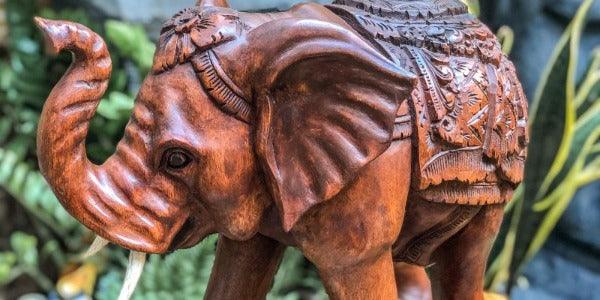Starting from clean blocks of reforestation wood such as teak , ebony and suar craftsmen from the Island of Bali have used very simple tools and refined skills to carve over the centuries using wood carving as the main vehicle of artistic and spiritual expression of Indonesian culture ; whose Hindu-Javanese connection sews the origin of Balinese fine arts , previously based on ritualistic purposes integrating art and religion.
Figurative art in wood developed in Bali around the 12th century, being guided by Hindu and Buddhist philosophies until the 13th and 14th centuries, when the province of Indonesia became a colony of Majapahit and the craftsmen of the kingdom expanded throughout the territory - moment the which Balinese art has been honed to achieve a diversity of styles without disconnecting from the spiritual purpose of each sculpture .

Sculpture left the religious character to assume the concept of art in the thirteenth century.
The Dutch invasion and colonization of the island of Bali at the beginning of the 20th century considerably affected artistic production , whose works of art were introduced and disseminated in Europe. With independence at the end of the century, Balinese sculpture underwent a transformation process and incorporated biomorphic art and contemporary style of carved wood , exploring beliefs and Balinese daily life with realistic and stylized human or animal figures, finely artistic.
In this period, wood art gained a commercial purpose and attracted western artists such as Rudolf Bonnet and Walter Spies to the island, influencing the styles of Balinese craftsmen and helping them to perfect their technical skills, promoting the rebirth of sculpture and the stylistic evolution of the crafts they left behind. from being "art for the gods" to becoming "art for art's sake". Bali, Central Java, Madura, Sumatra and Papua became the main centers of wood carving at the time.

The stylistic evolution of Balinese handicrafts can be seen in the animal sculptures.
To improve and maintain the quality of Balinese art , as well as to promote the sale of works outside Bali, Bonnet, Spies and the Balinese artist I Gusti Nyoman Lempad developed in 1934 an association of Balinese artists, the Pita Maha , which was abolished in 1942 due to World War II. This guild of Balinese fine arts was the driving force behind the renewal movement in Balinese sculpture.
Artists such as Ida Bagus Njana (Nyana), Ida Bagus Tilem, Doyotan, Sondoh, Ida Bagus Taman, Cokot, were able to play with proportions, lengthen or shorten the silhouette of sculptures that were previously painted and began to assume the beauty of the natural tone of the wood . This, in turn, considered a noble material, began to be studied to give the proper shine and texture or to accentuate the details of each type of sculpture, realistic and stylized.

The renewal movement in art favored the exploration of new proportions.
Artists Njana and Cokot were some of the most important, extending their artistic productions until the 60s and 70s - when Balinese sculpture flourished greatly inspired by their works of art , marked by simple and original lines less carved to give shape to decorative animals such as cats , owls , eagles , snakes , lizards , horses and elephants featured as pop art .
By promoting tourism in Bali during this period, the Balinese government encouraged the manufacture and sale of arts for decorative purposes in the archipelago, in addition to traditional crafts for spiritual purposes. This scenario creatively favored artisans who explored new styles and techniques of wood carving without straying from the Balinese essence recognized around the world.

The sculptures acquired the decorative purpose transforming the art of Bali.
Access our virtual store to discover curiosities, extra information and check out the beauty of Bali's decorative animal sculptures .
Namaste!
Milene Sousa - Art & Tune













